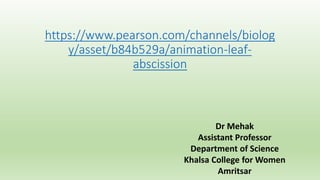Leaf abscission and senescence.pptx
•Download as PPTX, PDF•
0 likes•221 views
Abscission refers to the normal separation of senescent plant organs like leaves. It is a controlled process initiated during organ development with the formation of an abscission zone, a distinct layer of cells formed transversally across the petiole base. The abscission zone contains two layers - the abscission layer and protective layer. During abscission, the cells of the abscission layer separate due to dissolution of middle lamellae and cell walls by enzymes. Physiological changes also occur like chlorophyll degradation, decreased auxin, and increased ethylene production, which promote formation of cell wall degrading enzymes and abscission layer separation.
Report
Share
Report
Share

Recommended
Recommended
More Related Content
What's hot
What's hot (20)
Similar to Leaf abscission and senescence.pptx
Similar to Leaf abscission and senescence.pptx (20)
Unit1 part 1 (1).pptx dicot anatomy in which it will show the anatomical stru...

Unit1 part 1 (1).pptx dicot anatomy in which it will show the anatomical stru...
Recently uploaded
Recently uploaded (20)
Use of mutants in understanding seedling development.pptx

Use of mutants in understanding seedling development.pptx
Cot curve, melting temperature, unique and repetitive DNA

Cot curve, melting temperature, unique and repetitive DNA
Role of AI in seed science Predictive modelling and Beyond.pptx

Role of AI in seed science Predictive modelling and Beyond.pptx
COMPOSTING : types of compost, merits and demerits

COMPOSTING : types of compost, merits and demerits
Site specific recombination and transposition.........pdf

Site specific recombination and transposition.........pdf
Understanding Partial Differential Equations: Types and Solution Methods

Understanding Partial Differential Equations: Types and Solution Methods
Human & Veterinary Respiratory Physilogy_DR.E.Muralinath_Associate Professor....

Human & Veterinary Respiratory Physilogy_DR.E.Muralinath_Associate Professor....
development of diagnostic enzyme assay to detect leuser virus

development of diagnostic enzyme assay to detect leuser virus
Pteris : features, anatomy, morphology and lifecycle

Pteris : features, anatomy, morphology and lifecycle
The Mariana Trench remarkable geological features on Earth.pptx

The Mariana Trench remarkable geological features on Earth.pptx
Efficient spin-up of Earth System Models usingsequence acceleration

Efficient spin-up of Earth System Models usingsequence acceleration
Thyroid Physiology_Dr.E. Muralinath_ Associate Professor

Thyroid Physiology_Dr.E. Muralinath_ Associate Professor
Cyathodium bryophyte: morphology, anatomy, reproduction etc.

Cyathodium bryophyte: morphology, anatomy, reproduction etc.
Leaf abscission and senescence.pptx
- 1. https://www.pearson.com/channels/biolog y/asset/b84b529a/animation-leaf- abscission Dr Mehak Assistant Professor Department of Science Khalsa College for Women Amritsar
- 3. Abscission • Abscission refers to the normal separation of a senescent plant organ • It occurs to shed or separate the unnecessary plant parts or organs • For instance, shedding of old leaves at the base of the petiole which usually occurs during autumn • It is a controlled process that, in most cases, is initiated during the development of the organ by the formation of an abscission zone
- 4. • In a mature leaf, prior to abscission, a distinct zone of few layers of cells is formed transversally across the petiole base. This zone is called Abscission zone • Abscission zone has two layers :- (i) abscission (or separation) layer, and (ii) protective layer Abscission Layer – • The cells of abscission layer are thin walled parenchymatous and without the deposition of suberin and lignin • The vascular bundles in the abscission layer are also reduced in size • The cells of the abscission layer separate from each other due to the dissolution of middle lamella and primary wall of cellulose by the activity of pectinase and cellulase enzymes
- 6. Protective Layer – • A corky layer containing suberin and lignin forms beneath the abscission layer to protect the exposed surface after leaf fall from dessication and infection. The process of abscission is initiated and proceeds as follows: The parenchyma cells start dividing rapidly They secrete a layer of suberin in the walls nearest the stem The middle lamella, cell walls and the cells of the abscission zone dissolve (enzymatic degradation) Detachment of leaf – at this stage, the petiole remains attached to the stem by vascular elements only. But due to its own weight and the wind force, the leaf is detached from the stem
- 7. The broken vascular elements are soon plugged with tyloses and gums in xylem and callose in the phloem to stop translocation of water and food In some woody plants, another protective layer called periderm is developed by cork cambium below the first protective layer.
- 9. Physiological changes associated with abscission : Degradation of chlorophyll – During abscission, the colour of the leaves, flowers and fruits changes due to degradation of chlorophyll and the synthesis of anthocyanin pigment takes place Auxin decreases – abscission starts when the amount of auxin begins to decrease Ethylene production increases – due to which formation of cell wall degrading enzymes in the abscission zone takes place
- 14. Formation of abscission layer – Leaf abscission takes place at the base of the petiole. The site of abscission is internally marked by a distinct zone called abscission zone. The zone is made up of one or more layers of cells arranged transversely across the petiole base. This is called abscission layer. Dissolution of Middle Lamellae – The cells of the abscission layer separate from each other due to the dissolution of middle lamellae and the primary cellulose walls under the influence of the activity of enzymes, pectinase and cellulase. Physiological changes associated with abscission (Contd.)
- 18. 3. Simultaneous/Synchronous senescence In perennial, polycarpic, deciduous trees all the leaves senesce and die and shed at the same time, called the leaf fall, that occurs in a particular season usually in autumn, e.g., Poplar, Maple, Mulberry, Dalbergia, etc.
- 22. THANK YOU
Editor's Notes
- It is controlled by environmental factors since the deciduous trees lose their leaves in winter. The nutrients are exported from the leaves